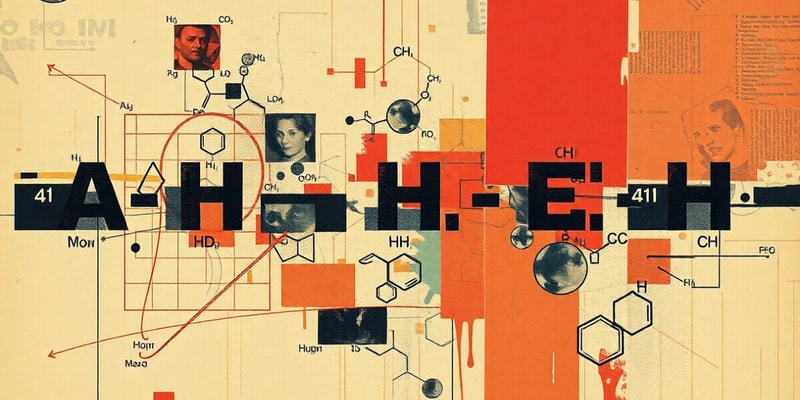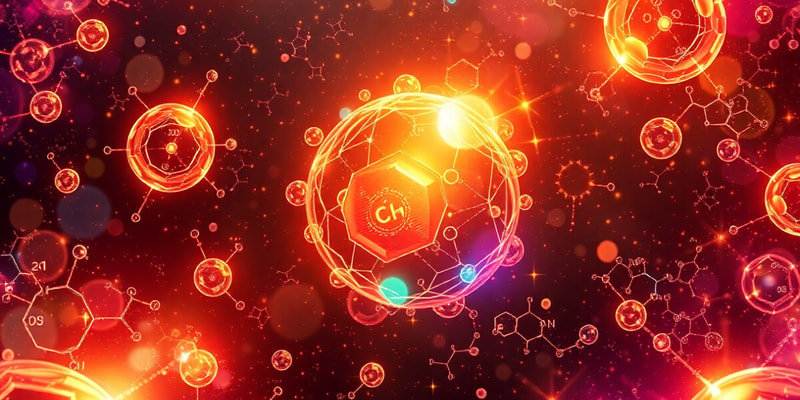Podcast
Questions and Answers
What is the charge of the lithium ion formed from lithium carbonate?
What is the charge of the lithium ion formed from lithium carbonate?
Li+
Identify the charge of the sulfide ion and explain how it is derived.
Identify the charge of the sulfide ion and explain how it is derived.
S2–; it gains 2 electrons.
How is the name of the nitrate ion derived from its element?
How is the name of the nitrate ion derived from its element?
It is named by adding '-ate' to the stem of nitrogen.
What is the difference in naming between the oxide and hydroxide ions?
What is the difference in naming between the oxide and hydroxide ions?
Signup and view all the answers
What suffix indicates that an anion has one less oxygen than its '-ate' counterpart?
What suffix indicates that an anion has one less oxygen than its '-ate' counterpart?
Signup and view all the answers
What is the systematic name of the cation with the formula Fe3+?
What is the systematic name of the cation with the formula Fe3+?
Signup and view all the answers
How does the naming convention differ for Copper(I) and Copper(II) ions?
How does the naming convention differ for Copper(I) and Copper(II) ions?
Signup and view all the answers
Which cation always has a +2 charge regardless of its compound?
Which cation always has a +2 charge regardless of its compound?
Signup and view all the answers
What is the old name for the cation Sn4+?
What is the old name for the cation Sn4+?
Signup and view all the answers
Define the term 'cation' in terms of electron transfer.
Define the term 'cation' in terms of electron transfer.
Signup and view all the answers
What naming convention is used to distinguish between two ions of the same element?
What naming convention is used to distinguish between two ions of the same element?
Signup and view all the answers
What is the charge of the cation represented by Pb3+?
What is the charge of the cation represented by Pb3+?
Signup and view all the answers
In which group of the periodic table do elements typically form cations with a +1 charge?
In which group of the periodic table do elements typically form cations with a +1 charge?
Signup and view all the answers
Identify the ion with the formula $HPO_4^{2-}$ and describe its significance in biological systems.
Identify the ion with the formula $HPO_4^{2-}$ and describe its significance in biological systems.
Signup and view all the answers
What is the difference between nitrate ($NO_3^-$) and nitrite ($NO_2^-$) ions in terms of their oxidation states?
What is the difference between nitrate ($NO_3^-$) and nitrite ($NO_2^-$) ions in terms of their oxidation states?
Signup and view all the answers
Explain the relationship between bicarbonate ($HCO_3^-$) and carbonic acid in the context of acid-base balance in the body.
Explain the relationship between bicarbonate ($HCO_3^-$) and carbonic acid in the context of acid-base balance in the body.
Signup and view all the answers
List and describe two chemical properties of sulfate ($SO_4^{2-}$) that differentiate it from sulfite ($SO_3^{2-}$).
List and describe two chemical properties of sulfate ($SO_4^{2-}$) that differentiate it from sulfite ($SO_3^{2-}$).
Signup and view all the answers
Discuss the significance of the hydroxide ion ($OH^-$) in acidic and basic solutions.
Discuss the significance of the hydroxide ion ($OH^-$) in acidic and basic solutions.
Signup and view all the answers
What is the empirical formula of ascorbic acid given its mass percentage composition?
What is the empirical formula of ascorbic acid given its mass percentage composition?
Signup and view all the answers
Define the molecular formula of a compound and provide the molecular formula for Vitamin C.
Define the molecular formula of a compound and provide the molecular formula for Vitamin C.
Signup and view all the answers
What percentage of Vitamin C is made up of oxygen based on its mass percentage composition?
What percentage of Vitamin C is made up of oxygen based on its mass percentage composition?
Signup and view all the answers
Explain why Nathan Zohner's experiment regarding dihydrogen monoxide was effective in demonstrating people's chemical phobias.
Explain why Nathan Zohner's experiment regarding dihydrogen monoxide was effective in demonstrating people's chemical phobias.
Signup and view all the answers
List two properties of dihydrogen monoxide that contributed to public fear in Zohner's study.
List two properties of dihydrogen monoxide that contributed to public fear in Zohner's study.
Signup and view all the answers
What does the term 'common name' refer to in the context of inorganic chemical nomenclature?
What does the term 'common name' refer to in the context of inorganic chemical nomenclature?
Signup and view all the answers
How is the relative number of atoms represented in an empirical formula?
How is the relative number of atoms represented in an empirical formula?
Signup and view all the answers
What conclusion can be drawn from the results of Zohner's petition regarding public understanding of chemistry?
What conclusion can be drawn from the results of Zohner's petition regarding public understanding of chemistry?
Signup and view all the answers
What is the systematic name for HClO3?
What is the systematic name for HClO3?
Signup and view all the answers
How would you name the compound CaCl2 in systematic nomenclature?
How would you name the compound CaCl2 in systematic nomenclature?
Signup and view all the answers
What does the formula H2SO3 represent and how is it named?
What does the formula H2SO3 represent and how is it named?
Signup and view all the answers
Identify the anion derived from HClO2.
Identify the anion derived from HClO2.
Signup and view all the answers
What is the correct name for CuSO4 according to the systematic nomenclature?
What is the correct name for CuSO4 according to the systematic nomenclature?
Signup and view all the answers
What is the name and oxidation state of the cation in MnO2?
What is the name and oxidation state of the cation in MnO2?
Signup and view all the answers
Which oxoacid corresponds to the anion ClO4-?
Which oxoacid corresponds to the anion ClO4-?
Signup and view all the answers
What is the formula for sodium hypochlorite, and what is its w/w concentration mentioned?
What is the formula for sodium hypochlorite, and what is its w/w concentration mentioned?
Signup and view all the answers
What systematic name would be given to the compound K3C6H5O7?
What systematic name would be given to the compound K3C6H5O7?
Signup and view all the answers
How is the anion derived from carbonic acid (H2CO3) named?
How is the anion derived from carbonic acid (H2CO3) named?
Signup and view all the answers
Study Notes
Compounds
- A substance consists of atoms of two or more elements in a definite ratio.
- Empirical formula: The relative numbers of atoms of each element in a compound in terms of the chemical symbols of the elements as their lowest common multiple (LCM).
- Molecular formula: The actual number of atoms of each element present in a molecule.
Inorganic Chemical Nomenclature
- Cations: Positively charged ions formed by the loss of electrons from a neutral atom.
- Metals in groups I, II, and III have a characteristic charge number that corresponds to their group number (+1, +2, and +3 respectively).
- Some elements always form cations of one characteristic charge number.
- Anions: Negatively charged ions formed by the gain of electrons from a neutral atom.
- Monoatomic anions are named by adding "-ide" to the stem of the element name.
- Oxanions: Polyatomic ions containing oxygen.
- Named by adding "-ate" to the stem of the element name (excluding oxygen).
- Use "-ite" to indicate one less oxygen than its "-ate" homologue.
-
Naming Ionic Compounds:
- Write the cation first, then the anion.
- The word "ion" is omitted.
- Prefixes aren't used because the number of anions can be determined from the cation's charge.
Acids
-
Hydrogen halides:
- HCl = hydrogen chloride, aq.HCl = hydrochloric acid
- HBr = hydrogen bromide, aq.HBr = hydrobromic acid
-
Oxoacids
- Replace "-ate" with "-ic acid"
- Replace "-ite" with "-ous acid"
- H2CO3 = carbonic acid
- H2SO3 = sulfurous acid
Common Compounds in Pharmaceuticals
- Calcium Hydroxide (Ca(OH)2)
- Calcium Phosphate (Ca3(PO4)2)
- Calcium Carbonate (CaCO3)
- Magnesium Oxide (MgO)
- Zinc Oxide (ZnO)
- Manganese Sulfate (MnSO4)
- Copper Sulfate (CuSO4)
- Chromium Chloride (CrCl3)
- Sodium Molybdate (Na2MoO4)
- Potassium Iodide (KI)
- Sodium Selenate (Na2SeO4)
- Potassium Citrate (K3C6H5O7)
- Sodium Chloride (NaCl)
- Magnesium Chloride (MgCl2)
- Potassium Chloride (KCl)
- Iron Sulfate (FeSO4)
- Zinc Sulfate (ZnSO4)
- Potassium Hydroxide (KOH)
Studying That Suits You
Use AI to generate personalized quizzes and flashcards to suit your learning preferences.
Related Documents
Description
Test your knowledge on inorganic compounds and their nomenclature. This quiz covers empirical and molecular formulas, as well as the naming conventions for cations, anions, and oxanions. Perfect for chemistry students looking to reinforce their understanding.




